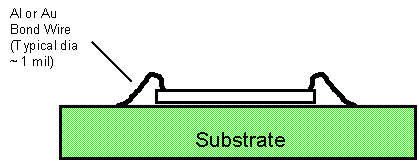Bond Wires
Introduction
Bond wires are a characteristic of wire-bonded packages. They are typically made of Gold or Aluminum. The number of bond wires in a package tends to be of the same order as the number of external leads/pins.
General Thermal Considerations
In most ceramic packages, a negligible portion of the heat from the Die flows to the substrate through the bond wires. However, in plastic packages this may not be the case. Bond wires play a significant role in the heat transfer within peripheral leaded packages such as the PQFP. In area-array plastic packages such as the PBGA, bond wires can be important, especially for a 2?layer substrate.
Modeling Options
FloTHERM PACK presently treats the bond wires as a combination of lumped cuboid blocks. A choice of an orthotropic or isotropic conductivity is given to the user. In the isotropic option, the conductivity of the bond wires in all the three directions is calculated by volume averaging. In the orthotropic option, the volume averaged value is assigned to the conductivity in the direction of the heat flow, while the other two directions are set to a conductivity of the Encapsulant.
Figure 4-17.
Bond Wires in a Peripheral Leaded Package and their Representation
The actual shape of the bond wires is in the form of a curved line. FloTHERM PACK approximates this as a straight line, or a combination of straight lines (see Figure 4-17 and Figure 4-18). The conductivity in the representative cuboid is adjusted to account for the different wire lengths between the actual bond wire and its model.
Figure 4-18.
Bond Wires in an Area Array Package and their Representation
Material Properties
Bond wires are typically made of Gold or Aluminum.
Conductivities:
Gold: 319 W/(m.K)
Aluminum: 237 W/(m.K)
Validation & References
- Sarang Shidore and Tien-Yu Tom Lee, A Comparative Study of the Performance of Compact Model Topologies and their Implementation in CFD for a Plastic Ball Grid Array Package, Proceedings of the InterPACK Conference, June 1999, Hawai’i, U.S.A.
